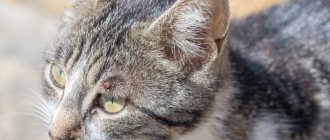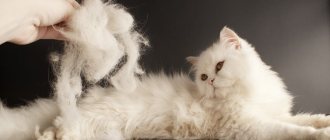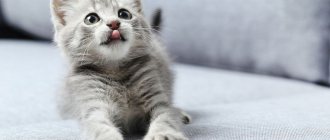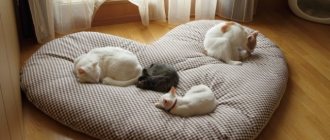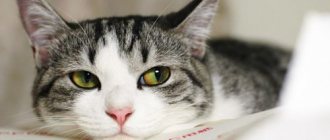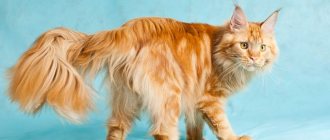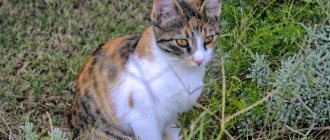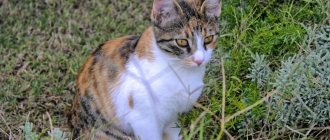We've all seen it. Your cat is cleaning herself and suddenly ends up with a clump of fur in her mouth. You run over to pull it out, but before you get to it, the cat swallows it whole. So you're starting to wonder: Why do cats eat their fur?
Cats eat fur due to excessive grooming and stress. Sometimes your cat can develop a severe condition such as pika if she eats too much hair. In most cases, cats accidentally eat their fur.
Cats groom themselves with their tongues, so they sometimes eat fur out of necessity. You might be shocked to learn that there's more to your cat's hair-eating habit, so keep reading to find out more.
Causes
Cats eating their own fur is actually quite common. Below are some of the many reasons why your cat is eating its fur and what you can do about it.
© shutterstock
- Regular care . While cats are grooming themselves, your cat may eat some of her fur. Your cat may not do this on purpose, but by grooming with her tongue, she may eat some.
- Your cat accidentally ate fur . Sometimes your cat may eat her fur because she can't spit it out while grooming herself. If they can't get it out of their mouth, the only option is to swallow it.
- Pica affects your cat . Fur eating may be due to a cognitive disorder called pica, which causes your cat to eat things it shouldn't, such as fur. This is more noticeable if you see your cat intentionally trying to eat fur outside of her normal grooming routine.
- Your cat has flea bites . Flea bites can cause your cat to bite her body and fur more often than usual. If your cat is uncomfortable, she may pull out more fur than usual to relieve the itching.
- Your cat may have dry skin . Dry skin can cause your cat to eat more of its fur as it tries to relieve itchy, dry skin problems.
- Stress affects your cat . A stressed cat is more likely to pull out its fur. This may not be part of grooming, but a nervous habit.
- Your cat is bored . Cats may sometimes eat fur because they are bored and may groom themselves excessively. If your cat is bored, be sure to do something to entertain him.
Reasons why a cat licks its skin a lot
Possible diseases
Wounds in the tail, belly and other parts of the body that the pet actively licks until blood appears can be the result of serious diseases. Pets often chew out their skin when the following pathological processes develop:
- invasive type deviations;
- diseases of the endocrine system;
- impaired metabolism;
- idiopathic syndrome in cats;
- pathologies associated with improper functioning of the excretory system;
- damage to internal organs located in the abdominal cavity.
Veterinarians warn owners that if a cat licks its fur down to the skin, this is a consequence of hormonal imbalance. A similar phenomenon is often observed during estrus or in a cat during pregnancy. If necessary, contact a specialist who will prescribe hormones.
Impact of stress
A state of stress can develop in a pet if the owners decide to change their habitual housing.
Sometimes a cat pulls out its fur and constantly licks its back due to a disturbed emotional state. The following factors can trigger stress:
- change of housing;
- relocation of one of the family members;
- loss of a frequently used toy;
- the appearance of another pet;
- sudden transition to a different diet.
Activity of ectoparasites
With frequent licking of fur, owners first need to examine the pet and find out if it has ticks, fleas, lice and other small parasites. In this case, the cat constantly chews out its paw and other parts of the body, trying to get rid of severe itching and discomfort. If you detect the activity of ectoparasites and bald patches on a cat’s fur, you should contact a veterinary clinic, where the owner will be told how to treat the animal. To prevent the problem of a cat licking its fur down to the skin, it is recommended to regularly treat your pet with special products.
Dermatological diseases
Often, a fluffy dog behaves this way when it has developed a skin disease.
Often the reason why cats lick their fur down to the skin is due to skin diseases. Thus, the animal tries to lick the wounds and restore the integrity of the epidermis. This behavior is observed on an instinctive level. If the owner notices a dermatological disease in time and tries to help the cat with special ointments and other external means, then it is worth not allowing the pet to lick the fur. For this purpose, use a collar or bandage the treated area with sterile cloth.
Allergic reaction
It is not uncommon for a cat to bite the skin and tear out fur when experiencing an allergy, accompanied by redness, itching and discomfort. A similar reaction occurs in domestic animals to the following stimuli:
- house dust;
- some plants;
- household chemicals.
Often this symptom is a reason to change the furry's diet.
Most often, the cause of allergies, due to which a cat licks its skin, is the consumption of certain foods. As soon as owners notice the appearance of bald spots, they should immediately review the pet’s diet. Perhaps some components of the feed are not suitable for the animal, then the product should be replaced with another. If nutritional correction does not produce positive results and the cat continues to lick its fur, then the veterinarian will prescribe medications with antihistamine effects.
Can cats eat their own fur?
Cats can eat their own hair, but if they eat their fur while grooming, they may cough up a hairball.
When cats groom themselves, the goal is not to eat their fur, even though you may catch your cat pulling out a knot or piece of fur. Unfortunately, because cats groom themselves with their tongues, it is impossible to spit out every strand of fur. This is especially difficult for long-haired cats.
If a cat eats fur, it doesn't just digest it like a piece of food. If a cat ingests too much fur, it will develop a hairball. I can tell you from experience that hairballs are no fun for you or your cat!
What happens to the wool next?
Vomiting of hair in a cat is usually observed in cases where the lump is so large that it does not pass into the duodenum. Such a lump is called a bezoar.
A bezoar is a foreign body in the stomach, which is a calculus of tightly matted hair or plant fibers. History includes many cases of bezoars in cats and only 400 cases in humans. Bezoars are divided into types depending on their composition. The lump formed by hair is called a trichobezoar. Moreover, it may include not only wool, but also inclusions of what the wool encountered in the stomach, for example, pieces of meat, bones or dry food.
If a hairball gets into the intestines, it will come out naturally without any unpleasant consequences or cause a number of dangerous conditions. This may be inflammation of the intestinal walls (up to the appearance of blood in the stool), as well as partial or complete blockage of the intestine.
Obvious signs of intestinal blockage are:
- the cat's appetite has decreased or disappeared;
- the cat has stopped going to the toilet in large quantities or goes only a little and with difficulty;
- the cat has a hard, enlarged, painful abdomen;
- The cat is lethargic and apathetic.
It must be remembered that visible signs may be absent.
The cause of blockage can be not only a bezoar, but also a swallowed foreign object. Therefore, in any case, the examination should be carried out by a veterinarian. Moreover, this condition not only causes discomfort, but can also lead to death.
Most likely, if the situation has not yet reached the point of no return, the doctor will prescribe medications that will help move the hairball through the digestive tract. The most affordable remedy is Vaseline or hair removal paste. But you cannot prescribe them yourself when the problem already exists, since they can aggravate the condition. This decision can only be made by a veterinarian after an examination.
If a cat goes to the toilet after taking medications, this is good. But, if she still does not go to the toilet, the lump is still there, and the gastrointestinal tract cannot function, either removal of the hairballs during endoscopy (if the hair is not far away) or abdominal surgery is prescribed, during which the surgeon removes the bezoar from the intestines.
A cat with an intestinal blockage will die in 2-7 days without the help of a veterinarian, so you can’t hesitate!
Article continues after advertisement
Is it normal for cats to eat their own hair?
It is normal for cats to eat their fur, especially when grooming themselves.
Because cats groom themselves with their tongues, they are accustomed to eating at least a little of their fur every day. You probably only worry about your cat eating fur when you see a large piece of fur hanging from his lip. Otherwise, do you think twice about the fact that your cat is eating its own fur while licking itself? Probably no.
Some cats are also very clean. If your cat pulls pieces of fur from her body, she may eat them even after she spits them out. This may seem like a strange habit, and it probably is, but cats do it anyway.
© shutterstock
Cats have trouble eating fur
If your cat eats its own fur while grooming, it won't harm your cat, but it's not necessarily good for your cat. Eating fur while grooming is not dangerous for your cat.
Eating fur can be a sign of diseases such as pica, which we will discuss next. However, sometimes cats eat their fur while bathing.
If you catch a cat eating a large piece of fur, you can remove it from its mouth, which is a good idea. Smaller pieces of fur are not too dangerous for your cat.
Why do cats eat hairballs?
It's terrifying to watch your cat eat their own hairball, but it's important to remind yourself that your cat is an animal, no matter what part of your family they are.
Cats sometimes do rude things. Probably high on that list is your cat eating a hairball. However, there is no compelling reason why your cat would eat a hairball. I always assumed this was because your cat is an animal and may not know better than to eat their hairball (or another cat's hairball!).
How to tell if your cat has pica
You know your cat is in pika if the cat has the urge to eat fur either from its own body or from the floor after it falls out.
Unfortunately, there are a few warning signs if your cat has pica. You can self-diagnose your cat by carefully observing her behavior to see if she grooms herself or if she suffers from pika.
The cat from the peak often eats its fur not only to wash itself. You may see your cat pulling out fur and eating it rather than spitting it out. If there is fur on the ground - from your cat or another cat in your home - a pike cat will likely eat it off the floor as a cat treat.
How to treat?
Constant licking of fur down to the epidermis is not normal and requires therapeutic measures. It is impossible to eliminate the problem without finding out its original source. To do this, contact a veterinarian who will conduct a diagnosis and select medications if necessary. Drug treatment is required for atopic dermatitis. To eliminate itching, the following medications are prescribed for cats:
When a pet licks its fur to the skin under the influence of stress factors, the cat needs to be provided with peace and surrounded with care. If pathological licking occurs against the background of an allergic reaction, then the influence of the irritant on the cat’s body is immediately excluded. If the violation does not go away, then additional antihistamines are prescribed. To combat the problem caused by small parasites, pet hair is treated. For this purpose, you can use antiparasitic drops, tablets or sprays.
How to get a cat to stop eating fur
Seeing your cat eating its fur can be difficult, but there are several ways to stop your cat.
Let's say your cat is long-haired and eats its own fur. The easiest way to keep your cat's hair short so she can easily reach it. You may not have adopted a long-haired cat to keep her fur short, but this is the best option for your cat if she eats her own hair.
Also try to understand why your cat eats its fur. His habit of eating fur from his pike? Is there a chance he has fleas or eczema?
Because cats cannot speak, cats are more difficult to diagnose, but it is important to remember that you must understand your cat's behavior in order to treat it appropriately.
Is it dangerous?
Frequent licking of a pet's fur should alert the owner. The following symptoms indicate the development of overgrooming:
- the appearance of bald patches in different parts of the body;
- areas with sparse hairs that often break;
- deterioration of the coat condition;
- signs of allergies;
- scratches, ulcers and other wounds on the skin of a cat that take a long time to heal;
- lethargy, apathy and reluctance to eat.
If the problem is neglected, it threatens to affect more areas on the animal’s body.
If you do not carry out treatment in time and do not get rid of the problem in which the cat licks the fur down to the skin, then there is a high probability of multiple bald spots appearing, which will deteriorate the appearance of the pet. When overgrooming, there is a risk of infection in the wounds, as a result of which an acute inflammatory process progresses in the deep structures of the epidermis. When a cat not only injures the skin through frequent licking, but also chews it out in pieces, necrotic lesions appear. Overgrooming is a common cause of disrupted natural hair replacement process.
